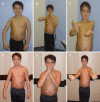Triangle tilt surgery as salvage procedure for failed shoulder surgery in obstetric brachial plexus injury
- PMID: 20668864
- PMCID: PMC2923723
- DOI: 10.1007/s00383-010-2673-7
Triangle tilt surgery as salvage procedure for failed shoulder surgery in obstetric brachial plexus injury
Abstract
Purpose: The study was conducted to review the effects of triangle tilt surgery in children with OBPI (obstetric brachial plexus injury) who had previously undergone several operative procedures at other hospitals before presenting at our institute.
Methods: The study included a group of 48 OBPI patients who had undergone previous operative procedures at outside hospitals by other surgeons. Patients were assessed for shoulder function using their radiological reports and the modified Mallet functional scale. The same patients underwent the triangle tilt procedure at our institution and were re-evaluated for shoulder function.
Results: The results of the study showed an increase in Mallet scores from 11.88 points to 15.17 points (p < 0.01), improvement in PHHA (percentage of humeral head anterior to the glenoid) from 14% to 25% (p < 0.05), enhancement in glenoid version from -32 degrees to -25 degrees (p < 0.01), and a decrease in the SHEAR (scapular hypoplasia, elevation, and rotation) deformity after surgery.
Conclusion: The data obtained demonstrated that the triangle tilt procedure significantly enhanced shoulder function and glenohumeral congruity in these patients as evidenced by the improvements in Mallet scores, PHHA, glenoid version, and SHEAR deformity.
Figures


Similar articles
-
Surgical normalization of the shoulder joint in obstetric brachial plexus injury.Ann Plast Surg. 2010 Oct;65(4):411-7. doi: 10.1097/SAP.0b013e3181e1335b. Ann Plast Surg. 2010. PMID: 20841993
-
Shoulder function and anatomy in complete obstetric brachial plexus palsy: long-term improvement after triangle tilt surgery.Childs Nerv Syst. 2010 Aug;26(8):1009-19. doi: 10.1007/s00381-010-1174-2. Epub 2010 May 16. Childs Nerv Syst. 2010. PMID: 20473676 Free PMC article.
-
Surgical correction of the medial rotation contracture in obstetric brachial plexus palsy.J Bone Joint Surg Br. 2007 Dec;89(12):1638-44. doi: 10.1302/0301-620X.89B12.18757. J Bone Joint Surg Br. 2007. PMID: 18057366
-
Age Influence Upon Glenohumeral Remodeling After Shoulder Axial Rebalancing Surgery in Brachial Plexus Birth Injury.J Pediatr Orthop. 2023 May-Jun 01;43(5):e389-e395. doi: 10.1097/BPO.0000000000002380. Epub 2023 Mar 6. J Pediatr Orthop. 2023. PMID: 36882889 Review.
-
Arthroscopic treatment for internal contracture of the shoulder secondary to brachial plexus birth palsy: report of a case series and review of the literature.Eur J Orthop Surg Traumatol. 2015 Oct;25(7):1121-9. doi: 10.1007/s00590-015-1670-x. Epub 2015 Jul 14. Eur J Orthop Surg Traumatol. 2015. PMID: 26169993 Review.
Cited by
-
Triangle tilt and steel osteotomy: similar approaches to common problems.Open Orthop J. 2011 Mar 24;5:124-33. doi: 10.2174/1874325001105010124. Open Orthop J. 2011. PMID: 21584207 Free PMC article.
-
Comparing functional outcome of triangle tilt surgery performed before versus after two years of age.Open Orthop J. 2011 Mar 16;5:59-62. doi: 10.2174/1874325001105010059. Open Orthop J. 2011. PMID: 21566737 Free PMC article.
-
10-year Follow-up of Mod Quad and Triangle Tilt Surgeries in Obstetric Brachial Plexus Injury.Plast Reconstr Surg Glob Open. 2019 Jan 22;7(1):e1998. doi: 10.1097/GOX.0000000000001998. eCollection 2019 Jan. Plast Reconstr Surg Glob Open. 2019. PMID: 30859023 Free PMC article.
-
Extended long-term (5 years) outcomes of triangle tilt surgery in obstetric brachial plexus injury.Open Orthop J. 2013 Apr 29;7:94-8. doi: 10.2174/1874325001307010094. Print 2013. Open Orthop J. 2013. PMID: 23730369 Free PMC article.
-
Successful outcome of triangle tilt as revision surgery in a pediatric obstetric brachial plexus patient with multiple previous operations.Case Rep Surg. 2014;2014:715389. doi: 10.1155/2014/715389. Epub 2014 Nov 23. Case Rep Surg. 2014. PMID: 25506033 Free PMC article.
References
MeSH terms
LinkOut - more resources
Full Text Sources

